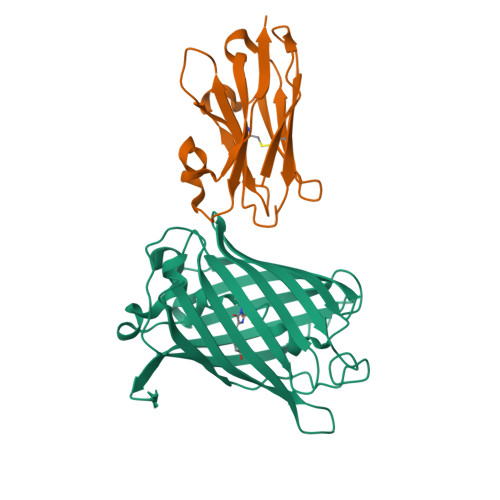Structure-based engineering of anti-GFP nanobody tandems as ultra-high-affinity reagents for purification.
Zhang, Z., Wang, Y., Ding, Y., Hattori, M.(2020) Sci Rep 10: 6239-6239
- PubMed: 32277083
- DOI: https://doi.org/10.1038/s41598-020-62606-7
- Primary Citation of Related Structures:
6LR7 - PubMed Abstract:
Green fluorescent proteins (GFPs) are widely used in biological research. Although GFP can be visualized easily, its precise manipulation through binding partners is still burdensome because of the limited availability of high-affinity binding partners and related structural information. Here, we report the crystal structure of GFPuv in complex with the anti-GFP nanobody LaG16 at 1.67 Å resolution, revealing the details of the binding between GFPuv and LaG16. The LaG16 binding site was on the opposite side of the GFP β-barrel from the binding site of the GFP-enhancer, another anti-GFP nanobody, indicating that the GFP-enhancer and LaG16 can bind to GFP together. Thus, we further designed 3 linkers of different lengths to fuse LaG16 and GFP-enhancer together, and the GFP binding of the three constructs was further tested by ITC. The construct with the (GGGGS) 4 linker had the highest affinity with a K D of 0.5 nM. The GFP-enhancer-(GGGGS) 4 -LaG16 chimeric nanobody was further covalently linked to NHS-activated agarose and then used in the purification of a GFP-tagged membrane protein, GFP-tagged zebrafish P2X4, resulting in higher yield than purification with the GFP-enhancer nanobody alone. This work provides a proof of concept for the design of ultra-high-affinity binders of target proteins through dimerized nanobody chimaeras, and this strategy may also be applied to link interesting target protein nanobodies without overlapping binding surfaces.
Organizational Affiliation:
State Key Laboratory of Genetic Engineering, Collaborative Innovation Center of Genetics and Development, Department of Physiology and Biophysics, School of Life Sciences, Fudan University, 2005 Songhu Road, Yangpu District, Shanghai, 200438, China.


















